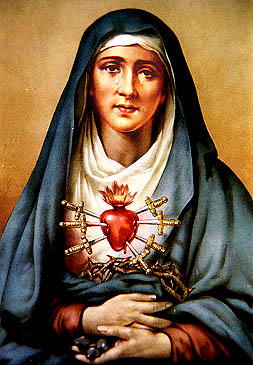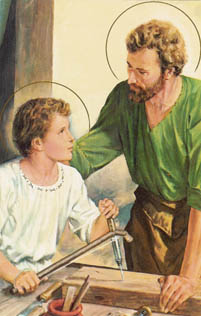
|
Vol. 26, Issue No. 92 |
|
| Saint Joseph and Communism |
 On the Way to Calvary – In Union with Our Sorrowful Mother
On the Way to Calvary – In Union with Our Sorrowful Mother
Represent to yourself the road that leads to Mount Calvary. At a certain spot, Mary, with the beloved disciple and a few more pious women, is waiting for Jesus, Who must needs pass there with His Cross on His shoulders.
FIRST REFLECTION. Consider, first of all, the conduct of Mary through the different phases of the life of her Divine Son. As long as Jesus lived a hidden life, Mary was with Him; but as soon as He went forth preaching, healing the sick, drawing after Him multitudes of people who admired Him and honored Him, Mary remained in concealment. Now Jesus is made the sport of infernal rage and human cruelty. He is condemned to death, denounced by priests and people as a malefactor, loaded with chains, scourged, and crowned with thorns, covered with ignominy and led to the place of His death with the Cross on His shoulders, and Mary reappears to share His humiliation. But, O Virgin of Virgins, art thou not afraid to mingle with that vile rabble? O Mother most loving, can thy Heart endure the sight of such cruel scenes? O holiest of all pure creatures, how can thy ears endure the blasphemies and scurrility of those incarnate demons? O no; nothing deters this heroic Mother from joining her suffering Son. Now is the time that she must come forth and show herself to be His Mother. Do you understand, pious soul, the lesson that Mary gives you in this fourth sorrow? You must not be satisfied to "know Christ," but you must know "Him crucified." It is not enough to follow Him on Mount Tabor, but you must follow Him on Mount Calvary. Do not expect to reap honor, praise and reputation from your piety and devotion; rather prepare yourself for contempt and persecution. For, as the Apostle says: "All that will live godly in Christ Jesus shall suffer persecution" (1 Tim. 3:12).
SECOND REFLECTION. Having heard from St. John that Jesus had been condemned, Mary at once leaves the house, and goes in advance of Jesus and stations herself at a certain corner where He was to pass. Everywhere the streets are thronged with multitudes. Heralds blow their trumpets and proclaim the sentence to the people. The crowd advances slowly...now and again there is a halt...shouts and yells fill the air with a terrific sound...Mary knows what it is...Alas, Jesus has fallen under the Cross. Never had maternal love been tortured so much as it is now in Mary's Heart. The anguish is unutterable. God, Who knows the depths of the ocean, knows it. Now Jesus has come up to her. He halts for a moment. She approaches to embrace Him, but the soldiers thrust her rudely back. Her eyes are fixed on His, His eyes fixed on hers; not a word is spoken by either of them, but their Hearts do understand the depth of their sorrow. See, He staggers, is overweighed by the burden of the cross, He falls with a dull, dead sound upon the street. Mary attempts to stretch out her arms to help Him. The crowd surrounds Him, like butchers round a fallen beast. They kick Him, beat Him, howl at and insult Him, and drag Him up again with cruel ferocity; and Mary is there. O pious soul, here ponder and consider if there can be a sorrow like that which rent the Hearts of Jesus and Mary in this meeting.
May 1, 2005 – 50th Anniversary of the Feast of St. Joseph the Worker
Saint Joseph and Communism
It was on the Feast of St. Joseph, March 19, 1937, that Pope Pius XI issued his Encyclical on "Atheistic Communism". Perhaps he chose this particular day because of St. Joseph's patronage over the Church. At least, in the Encyclical, the Holy Father named St. Joseph heavenly patron of the "vast campaign of the Church against world Communism." Why St. Joseph?
The Holy Father wrote: "To hasten the advent of the 'peace of Christ in the Kingdom of Christ' so ardently desired by all, we place the vast campaign of the Church against world Communism under the standard of St. Joseph, Her mighty protector. He belongs to the working class, and he bore the burdens of poverty for himself and the Holy Family, whose tender and vigilant head he was. To him was entrusted the Divine Child when Herod loosed his assassins against Him. In a life of faithful performance of everyday duties, he left an example for all those who must gain their bread by the toil of their hands. He won for himself the title of the 'Just', serving thus as a living model of that Christian justice which should reign in social life."
This paragraph indicates the Holy Father's thinking on the menace of Communism; for although it counts many intellectuals among its dedicated proponents, it is largely the working classes and the poor whom it enslaves. There is no doubt that Communism still offers an immense threat to the entire world in our day. Formerly it had overrun many countries, and though it has lost part of its grip, it seeks like a giant octopus to regain and extend its power. The problem of combating it grows ever more complex, because of its cunning and deceitful methods and the untiring zeal of its agents. It requires more than human skill to outwit and undo the "masters of deceit," who plan and direct its operations and carry them into execution with ruthless barbarity. The wisdom of appointing St. Joseph the heavenly patron of those combating this diabolical movement is clearly evident.
In 1955, Pope Pius XII further indicated St. Joseph's role in the fight against Communism when he proclaimed May 1st as the Feast of St. Joseph the Worker. This day had been set apart by the Communist Party as a day of worldwide public demonstrations on a grandiose scale, to proclaim the "glories" of Communism and to flaunt its claims of tremendous progress and power. By dedicating this day to St. Joseph, the Holy Father, so to say, Christianized it as a holyday for workmen, and thus offered a powerful challenge on the part of the Church to counteract the influence of Communism. In this decree, Pope Pius wrote: "The Church, always moved by religious considerations, has condemned the various systems of Marxist socialism and She condemns them still, for it is ever Her duty and right to save men from movements and influences that endanger their everlasting salvation." He continued: "We...hereby do institute the liturgical Feast of St. Joseph the Worker." He stressed the fact that this Feast was to be an opposing current to the discord, hatred and violence with which Communists had marked the celebration of their May-day.
The Feast of St. Joseph the Worker is intended to focus attention on work and the worker from the viewpoint of Christianity. Much is written on labor and its problems from an economic and social angle, with not the least intimation that religion has any part to play in this basic aspect of life. Pope Leo XIII, Pope St. Pius X, and Pope Benedict XV had already pointed to St. Joseph as the Church's "labor leader." Pope Leo XIII wrote: "By special right the needy and the laborers, all of lesser influence, ought to fly to the protection of St. Joseph and learn to imitate him." St. Pius X composed a most meaningful prayer to St. Joseph, Model of Laborers, which he often used. Pope Benedict XV wrote: "With great solicitude we place St. Joseph before those who work for a living, in order that they may follow him as their special guide and honor him as their heavenly patron." As the diabolical forces of Communism attempt to reclaim, to spread, and to deceive huge numbers of the gullible, the intercession of St. Joseph to save the world from Marxist enslavement is still very much needed.
Contact us: smr@salvemariaregina.info
Visit also: www.marienfried.com

